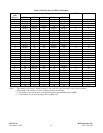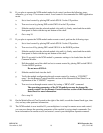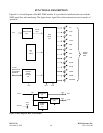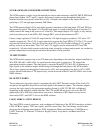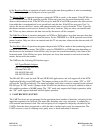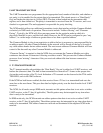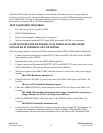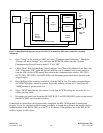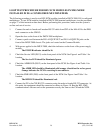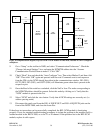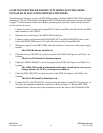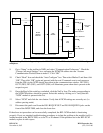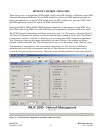RFL NCM RFL Electronics Inc.
November 6, 2007 26 (973) 334-3100
6. T1 RECEIVE MODULE
The T1 receive module clocks in the receive data at the proper time slot on the negative edge of the T1
clock, and latches it one clock following the time slot. The data is decoded as being either data or
idle/address frame, and as being low or high frame.
In NMS mode, the NCM will block all data until low and high address frames are received in
consecutive T1 frames, decoded, and then determined to be a valid BCD address. Once low and high
address frames are latched, the “Address Valid” signal is activated. Indication of “Address Valid” can
be observed at the ADRA and/or ADRB LEDs, and via the NMS software. Indication of T1 receive
can be observed at the RXA and/or RXB LEDs, and via the NMS software
7. ROGUE CONTROL
The Rogue Control feature is used to prevent a rogue PC program or another module from “stepping”
on the NCM time slot and bringing down the entire NCM path. If enabled, both the local input(s) and
T1 receive inputs will monitor for rogue activity. The local port is squelched for at least two minutes
once a continuous data stream lasting for greater than 60 seconds is detected. The T1 receive data is
squelched for at least two minutes once a continuous data stream lasting for greater than 64 seconds is
detected on the bus. The T1 rogue threshold is set intentionally higher than the local port to prevent all
the nodes from reacting to a rogue at any of the local ports. However, a rogue occurring on the T1 can
(initially) trip several of the rogue detectors because all of the nodes downstream “see” the same data
pattern. (Note that the T1 received data is also squelched on a frame-by-frame basis if the T1
data/addressing protocol is not maintained. In the NMS mode, the data would remain squelched until
valid a address is once again detected.) The 0.5 seconds RED/0.5 seconds OFF cadence indicates an
active rogue at RXA, RXB, IN1 or IN2 LEDs. An active rogue status is also indicated for each input
via the NMS software.
8. LOOP-BACKS
When the NCM is enabled for Equipment loop-back, the serial data received at IN1 and/or IN2 is re-
clocked by the UART receiver(s) and then re-transmitted out of OUT1 and/or OUT2 by the UART
transmitter(s) respectively. The error status conditions are inactive, parity is not checked or re-
generated, data is not transmitted onto the T1 bus, and the EQLB LED will be illuminated orange.
When the NCM is enabled for Payload loop-back, the UART transmitter is internally connected to the
UART receiver input. The IN1 or IN2 local inputs are ignored. The OUT1 or OUT2 is held high. The
error status conditions are active, parity is checked, and the data is re-transmitted back onto the T1 bus.
The PALB LED will be illuminated orange. Only one port is activated for Payload Loop-back at a
time. Note: In broadcast or NCM mode, all ports not in the test loop may receive corrupted data
because data is received simultaneously from two sources.
9. BAUD AND CLOCK GENERATOR
The Baud and Clock Generator module divides down the 49.152mHz frequency provided by the
external board oscillator (U11). It generates the 64X Baud required for the UARTS, and clock
frequencies used for synchronous timers by other modules in the Logic Array.



